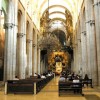- Accede I
- Regístrate I
- carrito
El Pórtico de la Gloria
La entrada oeste de la Catedral fue rematada en el año 1188 con la obra cumbre de la escultura románica: el Pórtico de la Gloria. Este soberbio conjunto de tres arcos, esculpido por el Maestro Mateo en sólo 20 años, dota al atrio del templo de un poderoso simbolismo cuya lectura engarzaba con la de las restantes fachadas exteriores: pecado original, Redención y Juicio Final. Más de 200 figuras de granito, tan vívidas y expresivas como no se habían representado nunca en la Edad Media, interaccionan como en un cuadro animado para componer un mensaje teológico centrado en la Salvación del Hombre.
El Pórtico, además, debe ser entendido como un conjunto simbólico de la Jerusalén Celeste formado por la cripta inferior, el propio pórtico de tres arcos y la galería de la tribuna, en la parte superior del templo, equivalentes a la Tierra, el Juicio Final y la Gloria.
Arco central
El Pórtico se compone de tres arcos, uno por cada nave de la Catedral, con sus respectivos tímpanos, arquivoltas y columnas; un zócalo inferior, una columna central o parteluz, lienzos de la contrafachada (hacia la fachada del Obradoiro) y bóveda.
En el arco central se eleva la visión apocalíptica de la Jerusalén Celeste: Cristo resucitado, rodeado por los cuatro Evangelistas y sus emblemas: Lucas escribe su Evangelio sobre el toro, Juan, sobre el águila; Marcos, sobre el león, mientras Mateo aparece con su caja de recaudador de impuestos. Entre ellos aparecen los Justos y debajo, un cortejo de ángeles que porta los instrumentos de la Pasión (columna, cruz, corona de espinos, lanza, etc). Sobre este conjunto, en la arquivolta, los 24 ancianos del Apocalipsis conversan entre sí mientras afinan los instrumentos con los que entonarán el canto de la Gloria.
Parteluz y zócalo
El patrón de la Catedral, Santiago Apóstol, preside la columna central de mármol. Este parteluz, labrado con el Árbol de Jesé o genealogía de Cristo, muestra a media altura las profundas huellas de las manos peregrinas.
El basamento que recorre el Pórtico representa monstruos, fieras y héroes de la Antigüedad aplastados por el triunfo de la Iglesia. Para otros autores, simbolizan un pasaje del Libro de Daniel.
Detrás de la columna se halla la figura del Maestro Mateo arrodillado, mirando devotamente al altar. A su lado está enterrado el arzobispo Pedro Muñiz (s. XIII), que consagró la Catedral en 1211.
Arcos laterales
Toda la mitad izquierda del Pórtico está dedicada al Antiguo Testamento o al Pueblo Judío, mientras que la mitad derecha representa el Nuevo Testamento y a los Gentiles.
El arco lateral izquierdo dae apoya sobre columnas que muestran a los profetas: de adentro hacia afuera, Moisés, Isaías, Daniel y Jeremías. Entre los rostros destaca la sonrisa de Daniel, que hizo historia por su naturalidad. Eran los primeros pasos del gótico en Compostela, anunciados también por la bóveda de crucería: es probable que el Maestro Mateo haya introducido este tipo de bóveda en España, pues ninguna es anterior a la que él usó en la cripta que sustenta el basamento del Pórtico. Pero hay quien prefiere ver en esa sonrisa del joven profeta un guiño hacia la figura de la bella Esther, junto a las puertas del Obradoiro, acompañada de otras figuras del Antiguo Testamento que hacen pensar a algunos estudiosos que el Pórtico es la representación en piedra de un drama litúrgico medieval, el Ordo Prophetarum. Esta pieza de música sacra es de hecho escenificada todos los años alrededor de Navidad en la Catedral.
El arco derecho, por su parte, se dedica al Juicio Final, y se apoya sobre figuras de apóstoles: Pedro, Pablo, Santiago y Juan, cuyo rostro también esboza una sonrisa. En las arquivoltas llama la atención la gráfica representación de los tormentos a los que son sometidos los condenados al Infierno: el bebedor trata de ingerir líquidos boca abajo; el goloso intenta comer una empanada mientras una serpiente le oprime la garganta; los avaros aparecen atados de pies y manos…
Frente a esta escena, junto a las puertas del Obradoiro, aparecen personajes del Nuevo Testamento como San Judas Tadeo, San Juan Bautista, San Bartolomé y Santo Tomás. De ellos suele decir la gente que están conversando, por lo que el Bautista los estaría riñendo y rogando silencio en el templo.
Restauración 2009 - 2018: Info aquí
Visitas al Pórtico de la Gloria: Info desde el 24/06/2021.
Fotos: ©Copyright: Programa Catedral_Fundación Barrié / Fundación Catedral
Ilustración: Isidoro González Adalid.











































